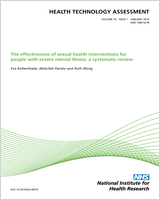Included under terms of UK Non-commercial Government License.
NCBI Bookshelf. A service of the National Library of Medicine, National Institutes of Health.
Pickard R, Starr K, MacLennan G, et al. Use of drug therapy in the management of symptomatic ureteric stones in hospitalised adults: a multicentre, placebo-controlled, randomised controlled trial and cost-effectiveness analysis of a calcium channel blocker (nifedipine) and an alpha-blocker (tamsulosin) (the SUSPEND trial). Southampton (UK): NIHR Journals Library; 2015 Aug. (Health Technology Assessment, No. 19.63.)

Use of drug therapy in the management of symptomatic ureteric stones in hospitalised adults: a multicentre, placebo-controlled, randomised controlled trial and cost-effectiveness analysis of a calcium channel blocker (nifedipine) and an alpha-blocker (tamsulosin) (the SUSPEND trial).
Show detailsMedical expulsive therapy had no effect in this large, pragmatic, UK-based, adequately powered, high-quality RCT with a low risk of bias. This should be considered by interested clinicians, guideline writers and health-care policy-makers, especially against the positive findings from previous meta-analyses of a number of predominantly small, low-quality trials. In particular, the key design aspects of the SUSPEND trial that directly relate to the current care pathway for people with ureteric colic in the UK NHS (including accurate diagnosis by CT KUB, expectant management at home after a short hospital stay and the outcome of need for further intervention) should be given due weight. The routine use of MET is currently recommended by relevant clinical guidance bodies, and recent cohort studies suggest that the majority of patients with ureteric colic are prescribed one of the agents, predominantly tamsulosin, although this remains an unlicensed use of the drug. The SUSPEND trial results should reverse this trend, and guideline writers will need to reconsider clinical practice recommendations and their strength in the light of our reliable and precise estimates of effect size. This is especially in light of the higher rate of participants in both the tamsulosin and nifedipine groups who discontinued trial medication owing to adverse effects compared with placebo. It is of particular importance for women (especially those of child-bearing age) prescribed tamsulosin, as this medication is not licensed for use in this patient group and, therefore, the necessary safety profile has not been established.
Our baseline measurements reinforce previous understanding that ureteric colic is associated with considerable pain and disturbance to health state, with the consequent increased use of health services and disruption of social and economic activity. The degree of ill health does appear to resolve for most sufferers of ureteric colic within 4 weeks, but there remains a minority (20% in this trial) of patients who fail to pass their stone spontaneously and in whom further intervention is required to remove it. This intervention inevitably leads to a further period of disability and ongoing use of health-care resources. Therefore, despite the null results concerning the clinical effectiveness of tamsulosin and nifedipine, there remains a need for simple treatments that can reduce the need for intervention, help relieve pain and hasten stone passage, and a number of agents are in the early phases of development. We consider research priorities to be:
- continued early-phase work to identify putative drugs or simple devices that show efficacy to hasten or increase likelihood of stone passage
- promising agents should be tested in multicentre studies adequately powered to demonstrate a useful treatment effect and designed to minimise important biases
- further work is required to investigate the phenomenon of large, high-quality trials showing smaller effect size than meta-analysis of several small, lower-quality studies. In particular, uncertainty regarding the results of these meta-analyses should be better communicated to the seeker of evidence both statistically and in the written conclusions of published papers
- work should be done to ensure that guideline-producing bodies and their writers are well-informed regarding the need for careful consideration and interpretation of findings from published meta-analyses and grade their practice recommendations cautiously.
- Recommendations and further research - Use of drug therapy in the management of ...Recommendations and further research - Use of drug therapy in the management of symptomatic ureteric stones in hospitalised adults: a multicentre, placebo-controlled, randomised controlled trial and cost-effectiveness analysis of a calcium channel blocker (nifedipine) and an alpha-blocker (tamsulosin) (the SUSPEND trial)
- Assessment of factors relevant to the NHS and other parties - Selective internal...Assessment of factors relevant to the NHS and other parties - Selective internal radiation therapies for unresectable early-, intermediate- or advanced-stage hepatocellular carcinoma: systematic review, network meta-analysis and economic evaluation
- Introduction - Management of Asthma in School age Children On Therapy (MASCOT): ...Introduction - Management of Asthma in School age Children On Therapy (MASCOT): a randomised, double-blind, placebo-controlled, parallel study of efficacy and safety
- Introduction and background - Treatments for hyperemesis gravidarum and nausea a...Introduction and background - Treatments for hyperemesis gravidarum and nausea and vomiting in pregnancy: a systematic review and economic assessment
- cytochrome b, partial (mitochondrion) [Cinara pinimaritimae]cytochrome b, partial (mitochondrion) [Cinara pinimaritimae]gi|635262944|gb|AHZ66251.1|Protein
Your browsing activity is empty.
Activity recording is turned off.
See more...